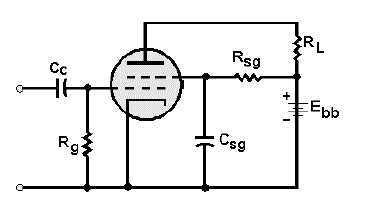1-45
Figure 1-31.—Basic tetrode circuit.
The problem now is: at what voltage and polarity should the screen grid be operated? If the screen
grid were operated at a potential that would make it negative in relation to the control grid, it would act as
a negative screen between the plate and control grid. As a result, gain would be reduced. If the screen grid
were operated at plate potential, it would draw current from the electron stream when the tube conducts.
Because of this, the value of Rsg is normally selected to cause the screen grid to be positive in relation to
the control grid, but not as positive as the plate.
Despite this precaution, the screen grid still draws some current from the electron stream. Any signal
applied to the control grid will appear at the screen grid inverted by 180º from the input signal. This is
undesirable, as it reduces the gain of the tube. Consider the effect if the control grid goes positive.
Conduction through the tube increases, and since the screen grid is in the electron stream, it will draw
some current. This causes the screen grid to go toward negative potential (less positive). The effect then,
is to place a negative-going electrode between the plate and positive-going control grid. The plate
becomes partially screened by the negative-going screen grid, and again, gain will decrease. Because the
signal at the screen grid is always 180º out of phase with the control grid, its effect will always be to
oppose the effect of the control grid.
To overcome this, a bypass capacitor (Csg) is connected between the screen grid and ground. The
addition of this capacitor will shunt, or pass, the ac variations on the screen grid to ground while
maintaining a steady dc potential on the screen grid. In other words, Csg moves all of the undesired effects
mentioned in the previous paragraph.
One very useful characteristic of the tetrode tube is the relationship between the plate and screen
grid. The screen grid will lessen the effect that a decreasing plate potential (negative-going signal) has on
conduction through the tube. In a triode, when the grid goes positive, the plate goes negative. This
decreases electrostatic attraction across the tube and tends to decrease the gain somewhat.
In a tetrode, the screen grid has the ability to isolate the effect that ac variations on the plate have on
the electron stream.
The positively charged screen grid will accelerate electrons across the tube even though the plate is
negative going. As long as the plate remains positive in relation to the cathode, it will draw off these
accelerated electrons. As a result, conduction through the tube when the plate is going negative will not
be decreased. This is another big advantage of screen-grid tubes.

